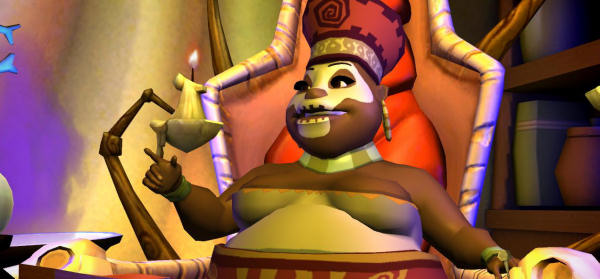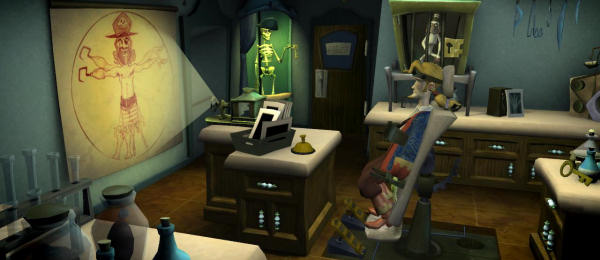Impressions: Tales Of Monkey Island Episode One
Due to adverse weather conditions and abnormal levels of volcanic activity, we've yet to bring you thoughts on the Tales of Monkey Island episodic adventures. Alongside the remake of the original by LucasArts, Telltale are currently producing five chapters of a brand new story for the hapless pirate, written and coded by many original LucasArts developers. The first of these, Launch Of The Screaming Narwhal, has been out for just over a month, and the second part has just appeared. (As Alec reported yesterday, you can now buy them individually in the US at least.) Here's some thoughts.
Clearly continuing the saga is always going to be an enormous task. The fourth part, Escape From Monkey Island, I completely loved at the time of release but it's been much derided since. I'm fascinated to go back and play it again, and intend to do so soon. It was, of course, created by Mike Stemmle and Sean Clark, the men behind Sam & Max: Hit The Road. And it's Stemmle who's in charge of this first episode at Telltale, writing and directing it.
The story follows all the right rules. Guybrush begins as a successful mighty pirate, now married to Elaine, with his own boat. But of course it all immediately goes wrong with the appearance of the evil Ghost Pirate LeChuck. Losing his boat, his bride, and naturally any shreds of dignity he may have scraped together, Guybrush not only inadvertently causes LeChuck to become human again, but manages to get his left hand possessed with some manner of evil ghost pirate voodoo disease. Shipwrecked on Flotsam Island, he discovers a town of washed up pirates (man, they didn't think of that joke!) trapped by unhelpful winds that won't allow any ship to sail.
So it's off to complete a typical Telltale three-task-trial, then a couple of extended trials, before one last puzzle to finish. It's a familiar pattern, honed through the mostly poor Sam & Max games, then refined in the splendid Strong Bad series. In this case, it works very well, pushing the game through to a good three or four hours (which isn't much shorter than the original Secret Of, as it happens). And for the most part, the puzzles themselves are fun and smart.
However, there are problems. The first, and the most steamingly obvious, is the utterly awful control system. It's completely mystifying, and if anything a mad-minded tribute to something that was definitely wrong with the fourth game. Moving Guybrush around the simple scenery is a mess. There's two ways to do it, one a kerbillion times worse than the other not very good one. Holding down the left mouse will sometimes cause a circle to appear around our hero's waist, with an arrow pointing in the direction he'll move. Drag the mouse and he'll follow it. Sort of. Hold down the right mouse and he'll run. Until he hits one of the invisible barriers that stick out a couple of feet from every object in the world. This then doubles in awfulness when you change screen, and everything reorientates, and your holding down the mouse causes him to turn 180 and immediately run back out the scene. The other option is to use the WASD keys, which certainly improves things a great deal, but doesn't get around the magical barriers, and nor another bewildering decision: to cover nearly every scene in fences. Ropes are strewn throughout the town, ensuring you can't simply run from one side to the other when on one of the inevitable treks back and forth across the island.
The other issue is the necessity to constantly retrace your steps to find a thing that might have changed. A locked door earlier may be open now. Someone who refused to help might offer up a solution later. Occasionally there are nudges, sometimes there aren't, and there's little fun to be found in charging around playing spot-the-difference. And retrace your steps you will, never more so than in the jungle. There's something of a strange tradition in adventures where every wood, forest or jungle must have unnavigable pathways, where turning around and going back down the path from where you just came takes you somewhere completely different. It forces you to solve a couple of decent map/audio-based puzzles, but later when you just want to get places, it's irritating.
Once you're safely inside a puzzle, it delivers very well. There's a lovely sequence with Guybrush trapped in a chair, only able to reach items with his feet. Piecing together what bells and pedals do what, and how to manipulate that to make good your escape, is tremendous. The largish puzzle at the end involving manipulating idols is similarly smart, with a lovely twist involving some cheese. A bunch of other highlights spring to mind that I shall not spoil, where fun ideas deliver, following the off-kilter logic traditional in such games.
Is it funny? Well, that's hard for me to say for you. But I didn't laugh at any point. I smiled a bunch, and I think there was one "heh". Like the original game, it doesn't attempt big punchlines, but rather a constant level of absurdity and silliness. Threepwood is once more voiced by Dominic Armato, who does a fantastic job. Unsurprisingly he's the stand-out character of the game. Disappointingly that's because most of the rest of the cast are so bland. The baddie (who I won't reveal) is at least a whopping great stereotype, but most of the islanders you meet are indistinguishable and disposable. Where's a Murray? Or a Stan? Of course the Voodoo Lady appears, and she plays her regular part well, but the series is crying out for a new character.
I fear it's hard to avoid damning the episode with faint praise. But it is praise after all. If it weren't so infuriatingly clunky, I imagine I would have warmed to it so much more. And I don't know whether it's just plain stubbornness now, but despite a more involved inventory that lets you combine items (although through another clunky interface, rather than just clicking them on each other - a system that seemed to work pretty well for the last twenty years), there's still no option to 'look at' separate from 'use'. This means sometimes left clicking will look at an object, other times it will have Guybrush pick it up, play with it, break it, etc. You look with your eyes, Guybrush, not your hands. Sure, it's more dialogue, but it would at least create the illusion of choice. I cannot imagine a significant chunk of potential audience would be lost by the complexity of left clicking to use, right to look.
On the basis of this single episode it's so hard to know whether it's worth investing in all five. It's a decent game, certainly. Were they individually sold outside of the States, then I'd say $9 was a sensible amount to try out four hours of smile-inducing puzzles. I think this will become more clear after playing episode two, on which I'll report later this week.




